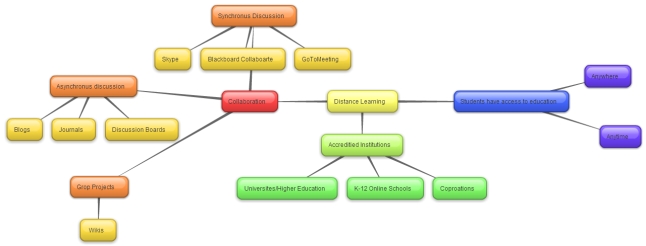For my first assignment in my EDUC 6135 course I was asked to reflect on the definition of distance learning and to express my view as to why the definition is constantly changing. I will then relate to you my personal definition of distance learning and what I feel the future of distance education will look like.
Distance education is defined by Simonson, M., Smaldino, S., Albright, M., & Zvacek, S. (2012) as “institution-based, formal education where the learning group is separated, and where interactive telecommunications systems are used to connect learners, resources, and instructors.”(p. 32). The key parts of this definition are that the instruction is “institution-based” or provided by an accredited college, university, or other educational facility. The teacher and class are separated by space and possibly time. Lastly the use of telecommunication allows the instructor to provide learning materials and resources for the student to use to learn. The telecommunication system also allows the student to connect and collaborate with other students as well as instructors.
I personally think and felt that distance education was when students would connect to the internet to access resources left by their instructor to help them with their course. After reviewing this week’s resources I find that it is more than just a place to find instructional materials and to discuss topics on discussion boards. Distance education is available not just for higher education but for all levels of school as long as it is offered by an accredited institution. Education is not the only one that uses distance learning as many corporations use it to train their employees. The best part about distance education and the internet is that the student can access their education at any time they want to as long as they have internet access. Also the interactivity of students has continued to evolve. The student can now have group projects online using wikis or have a face to face discussion with their class using Skype or other VOIP services.
Distance technology just like its definition is in a state of constant change and I feel that the future of distance education will be where distance education and face to face education merge into one large hybrid class. I feel that education will have students register for classes with the option if coming to a brick and mortar classroom for instruction or to be an online student. The classes could be recorded and the same assignments given in class can be given online with slight modifications for distance learning. This will allow the student the availability to come into a face to face class or if sick or unable to attend to view the class in real time on the internet or later via watching the recording. This will allow for a more student centered learning because the student can choose how and where they want to learn.
Technology has been evolving at a quicker and quicker rate of speed. As technology evolves so does all the areas of life including education. As computer software and hardware advance as well as internet tools, so will the creation and delivery of instructional materials. We are moving towards a completely student centered learning environment where the student chooses what to learn and when to learn it and if they want to be present in a class or connect via the internet.
References:
Simonson, M., Smaldino, S., Albright, M., & Zvacek, S. (2012). Teaching and learning at a distance: Foundations of distance education (5th ed.) Boston, MA: Pearson.

Daniel great to have you in class again. I will pop back in and read all of your post on Saturday. Have a great 4th.
Hello Daniel, welcome this class (Distance Learning). I hope to learn and explore new things about distance learning.